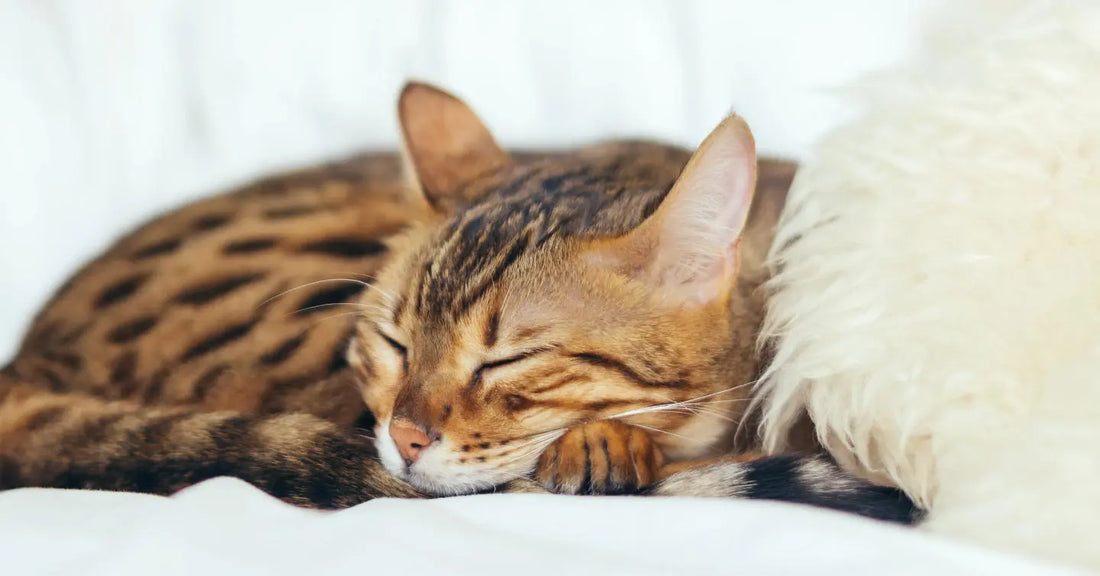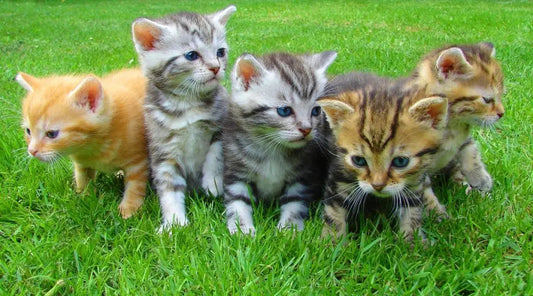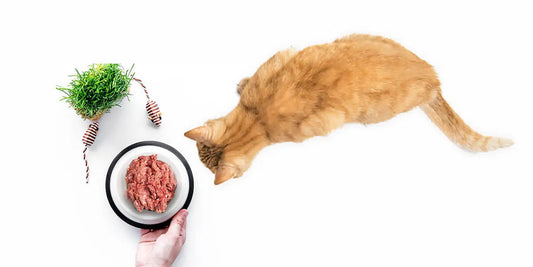
The Sleepy Secrets of Cats: Why Cats Sleep So Much
Written by Darwin's
Cats are famous for their frequent napping habits, often found curled up in sunlight or moonlight, seemingly indifferent to the source of warmth. Have you ever observed your cat's graceful yawn and stretch and pondered why cats sleep so much?
Read on to learn the low-down on cat sleep cycles, how much sleep is healthy for cats, and how to optimize your cat nap and sleep quality.
The Sleep Cycle of Cats
Unlike humans, cats are polyphasic sleepers, meaning they divide their sleep into several “cat naps” rather than sleeping through the night. Cat naps range from 50 to 113 minutes, with an average of 78. However, these short phases of sleep are frequent enough to add up—nearly 40% of cats sleep more than 18 hours per day, and more than half sleep between 12 to 18 hours per day.
Evolutionary Background of Cat Sleep
Contrary to popular belief, cats are not nocturnal, but rather crepuscular (most active at dawn and dusk) because of their ancestry. Over millions of years, felines have evolved to be low-light predators, meaning their eyesight works best in twilight.
By spreading naps throughout the day and night, they’re conserving energy that was once expended hunting during those peak hours, which is a typical cat behavior. These days, those same hunter instincts kick in, even though our precious pets don’t have to worry about chasing down a meal.
In fact, some research shows that modern cats now time their naps to mirror their owners’ sleep schedules and stay awake when we interact with them the most.
Comparing Cat Sleep to Other Animals
Aside from the rest of the cat family, many other members of the animal kingdom are crepuscular, including:
- Other mammals like otters, cottontail rabbits, bison, and ferrets
- Reptiles like rattlesnakes and Gila monsters
- Birds like chimney swifts and hummingbirds
- Bugs like mosquitoes and moths
- Fish like the brook trout
Over three-quarters of mammals share cats’ polyphasic sleep habits (we humans are actually the exception with our one long sleep period).
Like humans, cats experience both deep sleep or “REM” and light sleep or “NREM.” The ratio grows to favor light sleep as cats age, meaning your kitten is more likely to have dreams than an older cat or an adult cat.
Healthy vs. Unhealthy Sleep Patterns
Since kitties’ sleep habits are so vastly different from humans, it can be challenging to determine if your pet is suffering from a sleep disorder. But there are some key signs to look out for, and most common cat sleep struggles are very manageable with the help of a vet.
What’s Normal for Cats?
If you’re a new cat owner, you might find yourself up at night wondering, “Why does my cat sleep so much?” Don’t fret—soaking up copious amounts of beauty rest is standard in the feline world. Even if your cat regularly sleeps over 18 hours, they’re likely completely fine with their sleeping pattern.
You might notice your cat takes short, frequent naps throughout the day and night. They might be most active at dawn and dusk, per their instincts, or might adjust to your sleep pattern and schedule. Just be sure you’re feeding them on a regular schedule so that they can keep a consistent circadian rhythm.
Signs of Sleep Problems
The most common sleep disorders affecting cats are narcolepsy and the aptly named cataplexy, as well as insomnia in older kitties. Narcolepsy refers to sudden, uncontrollable REM sleep, and cataplexy refers to sudden muscle weakness, flaccidity, or paralysis while your cat is awake.
If your pet suddenly collapses onto their stomach or side, they might suffer from narcolepsy (if they appear asleep) or cataplexy (if they can’t follow motion with their eyes but still reacts to stimuli). These disorders are incurable but manageable, so be sure to consult your vet about keeping your pet safe while unattended and seek emergency care if needed. It’s also useful to understand how much a vet visit costs to plan for potential emergencies
If your older cat has become insomnia, waking or pacing during the night, it might simply be a product of old age (senility or cognitive dysfunction). However, this erratic sleep pattern can also be a symptom of hyperthyroidism (excess thyroid hormone production, which can lead to cardiac disease and high blood pressure). Consult your vet to determine the cause, and in any case, ask what oral melatonin supplements might support cat health.
Enhancing Your Cat’s Sleep Quality
Even if your cat is a healthy sleeper, there are steps you can take to ensure they’re getting the best shut-eye they can by observing their cat's body language. Just like you might enjoy an eye mask or white noise machine, certain perks will make your pet’s sleep that much more restful.
Ideal Sleep Environments for Cats
Cats like to sleep up high, and in warm, safe hiding places. Sometimes, they also prefer a cat low position in cozy spots. Choose a cat bed that’s just the right size for your cat. One with raised sides is ideal to increase warmth and help them feel safely tucked away. If you have a cat tree and feel comfortable doing so, place the cat bed on top.
Cats like to cuddle, so they might enjoy sleeping with you, your dog, or another cat. However, even if your cats like to snuggle, make sure they have their own designated beds to use as they choose.
Diet and Its Impact on Sleep
Ensuring your cat is eating an appropriate amount of nutritious, wholesome food has a direct impact on their quality of sleep, and vice versa. One study found that the amount of REM sleep cats had in the previous 12 hours correlated with the amount they ate in the next 12 hours, even more than previous food intake.
Cats also tend to fall asleep soon after eating, so consider adjusting your cat’s feeding schedule based on when they’ve been cat napping (or when you’d like them to).
Choosing a natural and fresh cat food packed with animal protein, vitamins, and minerals (mimicking wild cats’ prey) can help keep your cat at a healthy weight, which will, in turn, prevent conditions like sleep apnea.
Darwin’s Natural Pet Products: Promoting Better Sleep for Cats
Cats are known for sleeping a significant portion of their day. However, the quality of their sleep is more important than the quantity. Enhancing your cat's sleep quality can begin with their diet. When it comes to the natural, nutrient-dense, raw cat food your pet instinctively craves, Darwin’s has you covered. Our Natural Selections fresh cat food recipe is made with true raw, responsibly developed ingredients without hormones or preservatives. It’s expertly crafted based on felines’ ancestral diet. Inspired by nature; informed by science.
Sources:
Sleep Foundation. How Many Hours Do Cats Sleep? https://www.sleepfoundation.org/animals-and-sleep/how-much-do-cats-sleep
BBC Science Focus. Why do cats sleep so much? The hidden science of feline shuteye, explained. https://www.sciencefocus.com/nature/why-do-cats-sleep-so-much
Science Direct. Daily rhythm of total activity pattern in domestic cats (Felis silvestris catus) maintained in two different housing conditions. https://www.sciencedirect.com/science/article/abs/pii/S1558787812001220
Durango Herald. Crepuscular creatures and animal sleeping habits. https://www.durangoherald.com/articles/crepuscular-creatures-and-animal-sleeping-habits/
San Diego Zoo. Animal Slumber. https://stories.sandiegozoo.org/zoonooz/animal-slumber/
North Road Veterinary Care. 5 Reasons Your Cat isn't Sleeping at Night and How to Help. https://www.northroadvet.com.au/blog/5-causes-for-cats-not-sleeping-at-night-and-ways-to-help
Texas A&M University: Veterinary Medicine & Biomedical Sciences. Sleeping Disorders in Animals. https://vetmed.tamu.edu/news/pet-talk/sleeping-disorders-in-animals/
Companion Animal Psychology. How Much Do Cats Sleep, and Where Do They Prefer to Sleep? https://www.companionanimalpsychology.com/2020/06/how-much-do-cats-sleep-and-where-do.html#:~:text=Cats%20like%20hiding%20places%20and,top%20of%20a%20cat%20tree.&text=Cats%20that%20are%20part%20of,also%20sleep%20in%20close%20proximity.
National Library of Medicine. REM Sleep Predicts Subsequent Food Intake. https://www.ncbi.nlm.nih.gov/pmc/articles/PMC9044323/
Web MD. Nighttime Activity in Cats. https://www.webmd.com/pets/cats/nighttime-activity-cats
Cornell College of Veterinary Medicine. Feeding Your Cat. https://www.vet.cornell.edu/departments-centers-and-institutes/cornell-feline-health-center/health-information/feline-health-topics/feeding-your-cat


